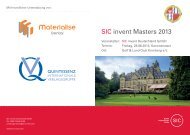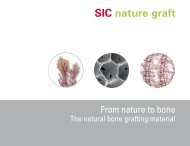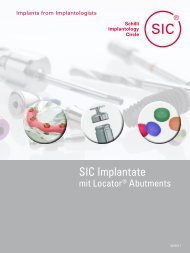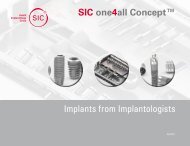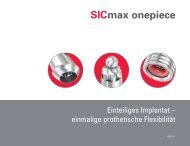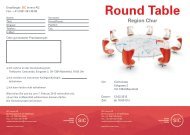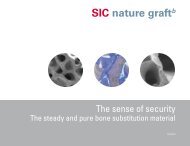SICmax onepiece - SIC invent
SICmax onepiece - SIC invent
SICmax onepiece - SIC invent
Create successful ePaper yourself
Turn your PDF publications into a flip-book with our unique Google optimized e-Paper software.
<strong><strong>SIC</strong>max</strong> <strong>onepiece</strong><br />
The <strong><strong>SIC</strong>max</strong> <strong>onepiece</strong> implant extends the product range of the very<br />
successful <strong>SIC</strong> implant system by a reduced-diameter, one-piece implant<br />
with a unique, multifunctional platform.<br />
User demand for a one-piece implant, which is equally indicated both for<br />
use in a «hybridprosthetic base restoration», as generally used with<br />
minimal horizontal bone availability, and also for high-quality, aesthetic<br />
fixed single-tooth restorations with a reduced gap width, led to a unique<br />
solution in collaboration with the Schilli Implantology Circle.<br />
The <strong><strong>SIC</strong>max</strong> <strong>onepiece</strong> implant fulfils the requirements of primary stability,<br />
outstanding osseointegration, preservation of the peri-implant hard and<br />
soft tissues, mechanical load-bearing capacity and precise, functional<br />
high-quality prosthetic restoration options – as with all <strong>SIC</strong> implant ranges.<br />
Surgical and prosthetic guideline<br />
max 2.0 mm<br />
Pilot drilling<br />
The depth of pilot drilling<br />
depends on the prosthetic<br />
planning.<br />
First, the thickness of the<br />
mucosa is ascertained<br />
using a small alveolar<br />
ridge incision or a probe.<br />
After loosening the<br />
mucosa and preparing the<br />
purchase point of the<br />
implant site, the length<br />
and axial direction of the<br />
implant are established<br />
using a Ø 2.0 mm pilot<br />
drill. Motor speed max.<br />
800 rpm.<br />
Reaming drilling<br />
The first drilling step of the<br />
Ø 2.8 mm stepped drill<br />
should be used in the case<br />
of very hard and compact<br />
bone. The final diameter of<br />
Ø 2.8 mm can also be<br />
drilled to a maximum depth<br />
of 2 mm. The insertion<br />
torque should, if possible,<br />
not exceed 40 Ncm throughout<br />
the flexible preparation.<br />
Motor speed max. 800 rpm.<br />
Length 9.5 mm 13.0 mm<br />
Ø 2.8 mm X X<br />
Align clip to buccal<br />
Insertion<br />
Place the implant directly<br />
using the insertion tool<br />
for a contra-angle<br />
(max. 25 rpm) or using the<br />
insertion tool S for the<br />
torque ratchet until the<br />
bottom edge of the insertion<br />
tool is at the required<br />
gingival level. The optimal<br />
gingival level and insertion<br />
depth should be determined<br />
pre-operatively<br />
depending on the planned<br />
prosthetic restoration.<br />
The <strong><strong>SIC</strong>max</strong> <strong>onepiece</strong> allows implantologists to use the surgical technique<br />
that most closely meets their personal preferences. In addition to<br />
«standard insertion» involving the raising of a flap, a minimally invasive,<br />
atraumatic «flapless technique» can also be used. The basic concept of<br />
this one-piece, cylindrical, endosseous screw-type implant is unsurpassed<br />
surgical and prosthetic flexibility and cost-effectiveness.<br />
The basic design of the implant is cylindrical with a widening of the thread<br />
core and a microthread in the crestal region.The tulip-shaped gingival<br />
emergence profile merges into a conical functional section, with a ball end<br />
for fitting O-ring attachments. The precise, rotationally secure prosthetic<br />
connection enables reliable cementation of all available prosthetic abutments.<br />
It has also been optimised for the requirements of CAD/CAM technology.<br />
Restoration with O-ring<br />
Attachment<br />
Relieve the denture liberally<br />
ensuring there is no contact.<br />
Align the O-ring attachment<br />
at right angles and<br />
polymerise into the denture.<br />
Then prepare and polish<br />
the denture. The O-rings<br />
can be easily replaced<br />
and are available in two<br />
withdrawal strengths.<br />
Restoration with<br />
<strong>SIC</strong> Retention Attachment<br />
Caution: Separate the ball<br />
head intraorally to the<br />
upper edge of the insertion<br />
level using plenty of<br />
coolant.<br />
Restoration with <strong>SIC</strong><br />
Standard Abutment,<br />
straight<br />
<strong>SIC</strong> Wax-up Abutment<br />
For fabricating custom-cast<br />
superstructures.<br />
Also suitable as a temporary<br />
abutment.



